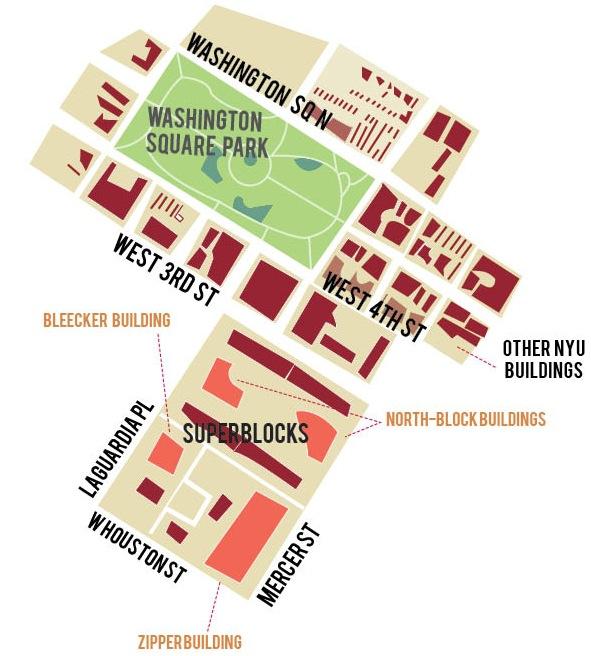2031 plan brought to Court of Appeals
NYU plans to build on the superblocks shown above as part of the 2031 Expansion Plan.
December 3, 2014
Opponents of the NYU 2031 expansion plan are appealing the Oct. 14 New York State Supreme Court decision that allowed the development of 2 million square feet of Greenwich Village. The case is being taken to the Court of Appeals in hopes of halting expansion and preserving parkland in the Village.
Deborah Glick, New York State Assembly member and plaintiff in the appeal, said she is confident the Court of Appeals will rule in their favor.
“I feel very strongly that the lower court that decided in our favor got the law right and that the appellate panel was wrong,” Glick said. “In the end, a fair hearing in front of the Court of Appeals will vindicate our appeal.”
Andrew Berman, executive director of the Greenwich Village Society for Historic Preservation and plaintiff in the appeal, said the preservation of parkland and the well-being of Greenwich Village residents are the two major reasons for the appeal.
“We’re appealing because we think it’s critical that the courts recognize the sanctity of public park space,” Berman said. “The 2031 expansion plan would have a devastating impact on the Village and it has been roundly opposed not just by residents of the Village but by NYU’s own faculty and staff and many of its students.”
NYU spokesman John Beckman said the appellants’ claims that NYU is building on parkland are false. In fact, Beckman said, the contested area is property of the Department of Transportation, as ruled by the New York State Supreme Court in its Oct. 14 decision.
“The opponents of the plan claim a group of strips of land on the superblocks is parkland; however, the Appellate Division of the New York State Supreme Court ruled it was not,” Beckman said. “It has never been mapped or designated by the City as parkland; it has always remained property of the Department of Transportation, not the Department of Parks.”
Beckman added that NYU does not intend to eliminate park space in the Village. Instead, it plans to create more park space at the conclusion of the expansion.
In a Core Plan Fact Sheet released on Oct. 15, the university explains the parkland that will be preserved. The plan includes new public playgrounds, seating and gardens. The fact sheet can be found on the NYU website.
Professor Mark Crispin Miller, a member of NYU’s Faculty Against the Sexton Plan, said many opponents of the plan feel there was little transparency in constructing the expansion plan.
“The plan was hatched behind closed doors by the administration, without any academic rationale, and they’ve consistently refused to share their business plan, despite requests from the Faculty Senate Council, the Community Board, student groups, members of the press and individual faculty in Stern and Economics,” Miller said.
The final report of the Space Priorities Working Group, available online, released in March of this year, however, outlines the university’s rationale for the expansion.
Still, Miller said he believes this plan will not only hurt the residents of Greenwich Village, but also the university itself.
“Aside from its disastrous impact on NYU’s neighborhood, this multi-billion-dollar project will put NYU itself at risk, financially and academically, and will only add to the already crushing load of student debt carried by NYU’s graduates,” Miller said.
A version of this article appeared in the Wednesday, Dec. 3 print edition. Email Alanna Bayarin at [email protected].















































































































































